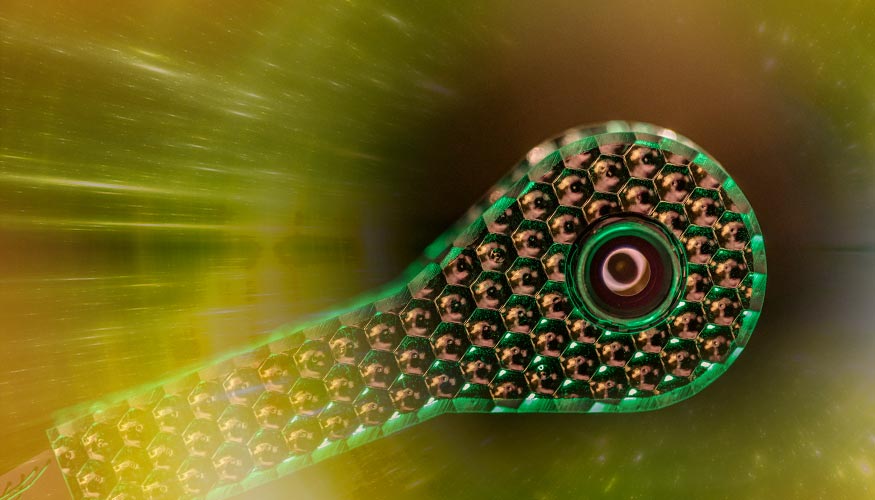Untuk menandai peringatan satu tahun pencapaian hasil yang lebih besar dari 1,3 megajoule di National Ignition Facility LLNL, hasil ilmiah dari eksperimen yang memecahkan rekor ini diterbitkan dalam tiga artikel yang ditinjau oleh rekan sejawat: satu di Physical Review Letters dan dua di Physical Review E Gambar bergaya ini menunjukkan target kriogenik yang digunakan untuk eksperimen fusi inersia yang memecahkan rekor ini. Kredit: James Wickboldt/LLNL
Setelah beberapa dekade penelitian fusi inersia, hasil lebih dari 1,3 megajoule (MJ) dicapai pertama kali pada tanggal 8 Agustus 2021. Hal ini membawa para ilmuwan di Lawrence Livermore National Laboratory (LLNL) National Ignition Facility (NIF) ke puncak perolehan fusi dan mencapai pengapian ilmiah.
Untuk menandai satu tahun pencapaian bersejarah ini, hasil ilmiah dari eksperimen yang memecahkan rekor ini diterbitkan dalam tiga makalah peer-review. Sebuah artikel diterbitkan di Surat Verifikasi Fisik dan dua di dalam Cek Fisik E. Di mana Surat Verifikasi Fisik Lebih dari 1.000 penulis disertakan dalam makalah ini untuk mengenali dan mengenali banyak individu yang telah bekerja selama beberapa dekade untuk membuat kemajuan yang signifikan ini menjadi mungkin.
“Rekor tembakan adalah kemajuan ilmiah besar dalam penelitian fusi, membuktikan bahwa pengapian fusi dimungkinkan di laboratorium di NIF,” kata Omar Hurricane, peneliti utama untuk program fusi kurungan inersia LLNL. “Mencapai kondisi yang diperlukan untuk pengapian telah lama menjadi tujuan untuk semua penelitian fusi kurungan inersia dan membuka pintu ke rezim eksperimental baru di mana pemanasan sendiri partikel alfa mengungguli mekanisme pendinginan apa pun dalam fusi.[{” attribute=””>plasma.”
The results from August 8, 2021, are described in detail in the papers. They also include the associated design, improvements, and experimental measurements. LLNL physicist Alex Zylstra, lead experimentalist and first author of the experimental Physical Review E paper, noted that in 2020 and early 2021 the Lab conducted experiments in the “burning plasma” regime for the first time. These set the stage for the record shot.
“From that design, we made several improvements to get to the August 8, 2021, shot,” he said. “Improvements to the physics design and quality of target all helped lead to the success of the August shot, which is discussed in the Physical Review E papers.”
This experiment incorporated a few important changes, including an improved target design. “Reducing the coasting-time with more efficient hohlraums compared to prior experiments was key in moving between the burning plasma and ignition regimes,” said LLNL physicist Annie Kritcher, lead designer and first author of the design Physical Review E paper. “The other main changes were improved capsule quality and a smaller fuel fill tube.”
Since the experiment last August, the researchers have been executing a series of experiments to attempt to repeat the performance and to understand the experimental sensitivities in this new regime.
“Many variables can impact each experiment,” Kritcher said. “The 192 laser beams do not perform exactly the same from shot to shot, the quality of targets varies and the ice layer grows at differing roughness on each target. These experiments provided an opportunity to test and understand the inherent variability in this new, sensitive experimental regime.”
Although the repeat attempts have not reached the same level of fusion yield as the August 2021 experiment, all of them demonstrated capsule gain greater than unity. They have had yields in the 430-700 kJ range, which are significantly higher than the previous highest yield of 170 kJ from February 2021. The data gained from these and other experiments are providing crucial clues as to what went right and what changes are needed in order to not only repeat that experiment but also exceed its performance in the future. The scientists are also utilizing the experimental data to increase understanding of the fundamental processes of fusion ignition and burn. They’re also working to enhance simulation tools in support of stockpile stewardship.
Looking ahead, the research team is working to leverage the accumulated experimental data and simulations to move toward a more robust regime – further beyond the ignition cliff – where general trends found in this new experimental regime can be better separated from variability in targets and laser performance.
Efforts to increase fusion performance and robustness are underway via improvements to the laser and improvements to the targets. Additionally, they’re working on modifications to the design that further improve energy delivery to the hotspot while maintaining or even increasing the hot-spot pressure. This includes improving the compression of the fusion fuel, increasing the amount of fuel, and other avenues.
“It is extremely exciting to have an ‘existence proof’ of ignition in the lab,” Hurricane said. “We’re operating in a regime that no researchers have accessed since the end of nuclear testing, and it’s an incredible opportunity to expand our knowledge as we continue to make progress.”
References:
“Lawson Criterion for Ignition Exceeded in an Inertial Fusion Experiment” by H. Abu-Shawareb et al. (Indirect Drive ICF Collaboration), 8 August 2022, Physical Review Letters.
DOI: 10.1103/PhysRevLett.129.075001
“Experimental achievement and signatures of ignition at the National Ignition Facility” by A. B. Zylstra et al., 8 August 2022, Physical Review E.
DOI: 10.1103/PhysRevE.106.025202
“Design of an inertial fusion experiment exceeding the Lawson criterion for ignition” by A. L. Kritcher et al., 8 August 2022, Physical Review E.
DOI: 10.1103/PhysRevE.106.025201

“Ninja twitter bersertifikat. Ahli internet. Penggemar budaya pop hardcore. Baconaholic.”
You may also like
-
Aturan matematika ditemukan di balik distribusi neuron di otak kita
-
Para ilmuwan menemukan penjelasan untuk lubang gravitasi raksasa di Samudra Hindia
-
Peta baru yang akurat dari semua materi di alam semesta dirilis
-
Para ilmuwan mengatakan sepasang bintang yang sangat langka berperilaku sangat ‘aneh’
-
Lima Angsa Tewas Setelah Terbang Ke Saluran Listrik Hinkley | Berita Inggris

